Marks & Spencer: Leadership, Management Roles, and Operations Analysis
VerifiedAdded on 2020/07/23
|12
|3812
|35
Report
AI Summary
This report analyzes the roles and responsibilities of leaders and managers at Marks & Spencer (M&S), a prominent retail firm. It explores the distinctions between leaders and managers, highlighting their functions in setting goals, managing risk, and developing employee relationships. The report delves into various leadership theories, including situational, contingency, and system theories, and their application within M&S. Furthermore, it examines different approaches to operations management, such as business process redesign, Six Sigma, lean manufacturing, and reconfigurable manufacturing systems, providing insights into how M&S can optimize its operations. The report concludes by summarizing the key findings and implications for effective leadership and management practices within the organization.
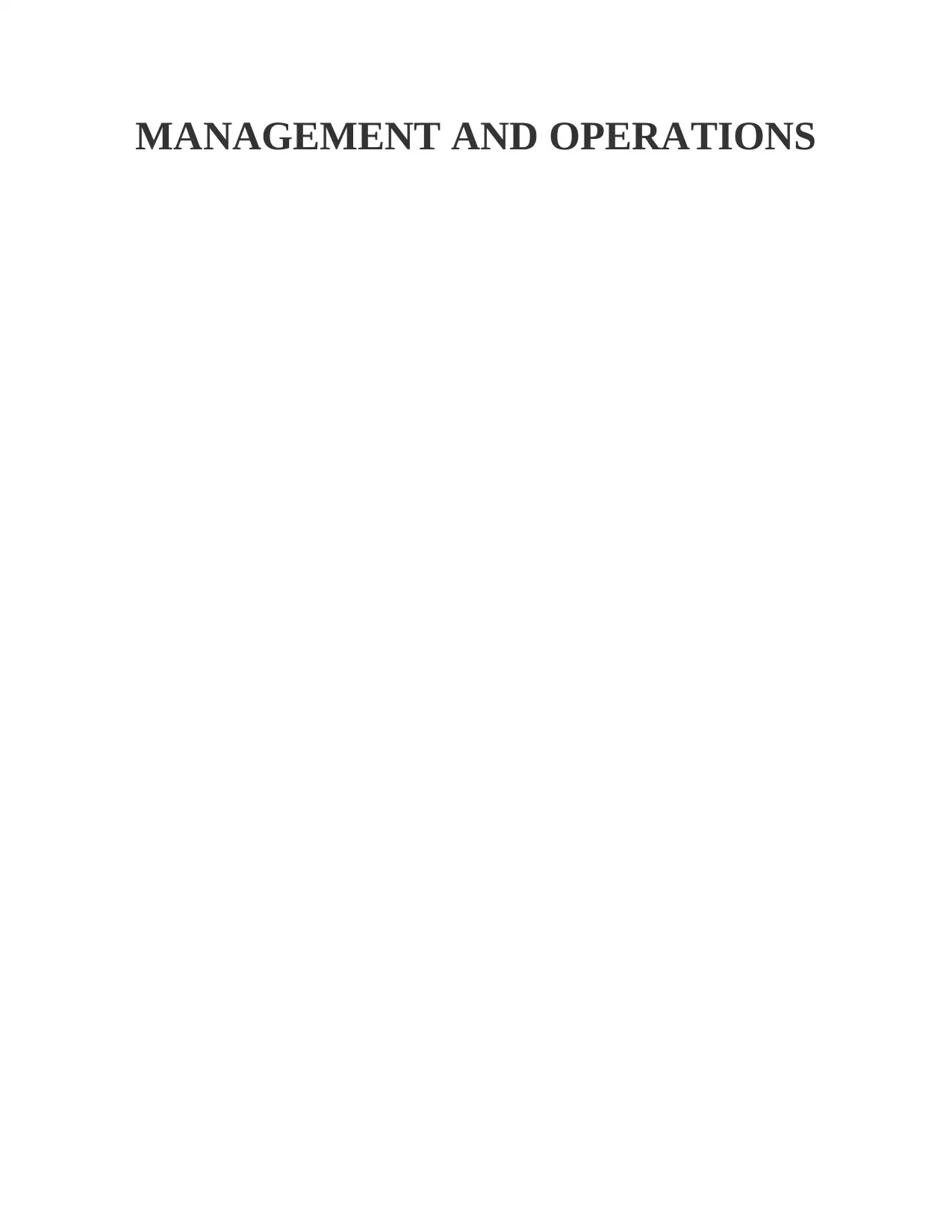
MANAGEMENT AND OPERATIONS
Paraphrase This Document
Need a fresh take? Get an instant paraphrase of this document with our AI Paraphraser
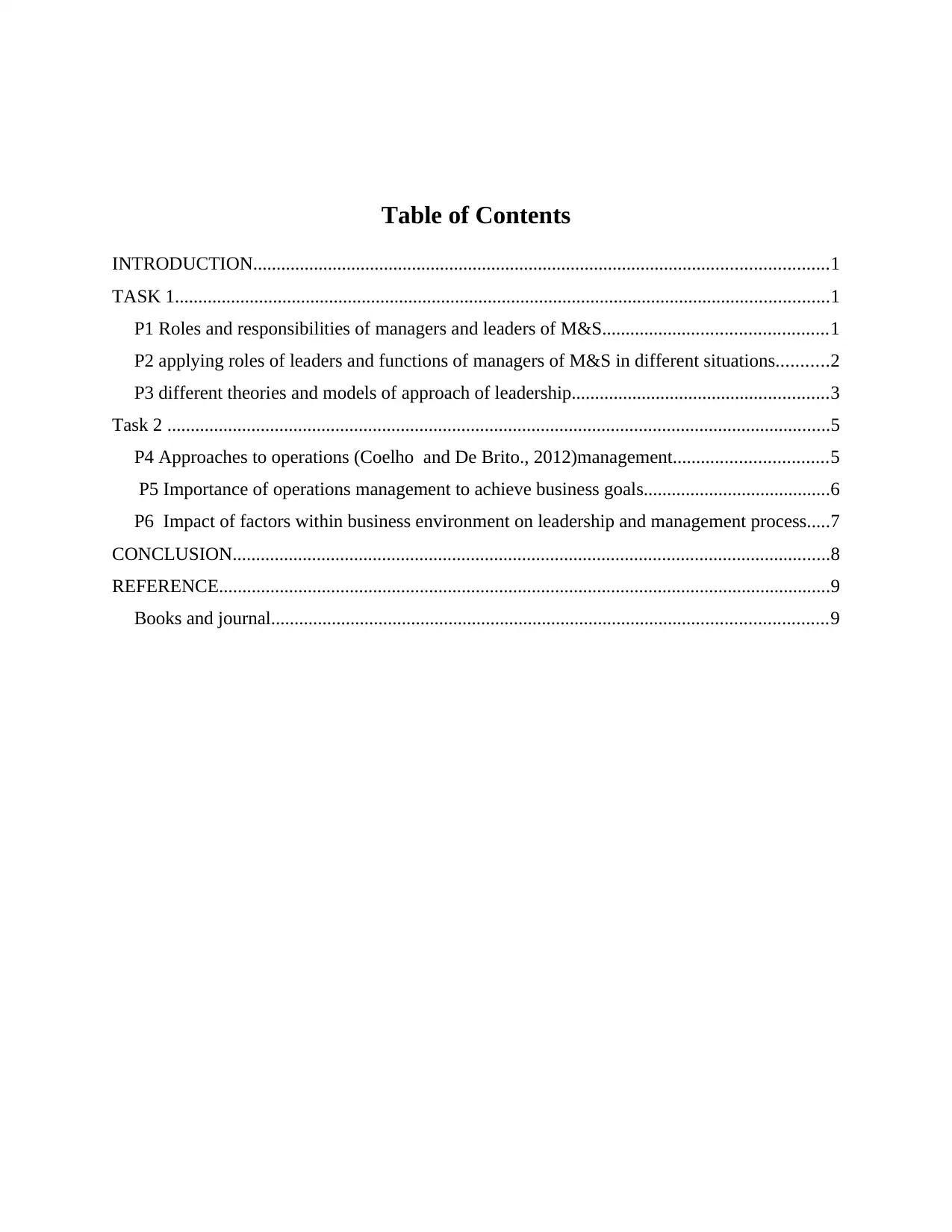
Table of Contents
INTRODUCTION...........................................................................................................................1
TASK 1............................................................................................................................................1
P1 Roles and responsibilities of managers and leaders of M&S................................................1
P2 applying roles of leaders and functions of managers of M&S in different situations...........2
P3 different theories and models of approach of leadership.......................................................3
Task 2 ..............................................................................................................................................5
P4 Approaches to operations (Coelho and De Brito., 2012)management.................................5
P5 Importance of operations management to achieve business goals........................................6
P6 Impact of factors within business environment on leadership and management process.....7
CONCLUSION................................................................................................................................8
REFERENCE...................................................................................................................................9
Books and journal.......................................................................................................................9
INTRODUCTION...........................................................................................................................1
TASK 1............................................................................................................................................1
P1 Roles and responsibilities of managers and leaders of M&S................................................1
P2 applying roles of leaders and functions of managers of M&S in different situations...........2
P3 different theories and models of approach of leadership.......................................................3
Task 2 ..............................................................................................................................................5
P4 Approaches to operations (Coelho and De Brito., 2012)management.................................5
P5 Importance of operations management to achieve business goals........................................6
P6 Impact of factors within business environment on leadership and management process.....7
CONCLUSION................................................................................................................................8
REFERENCE...................................................................................................................................9
Books and journal.......................................................................................................................9
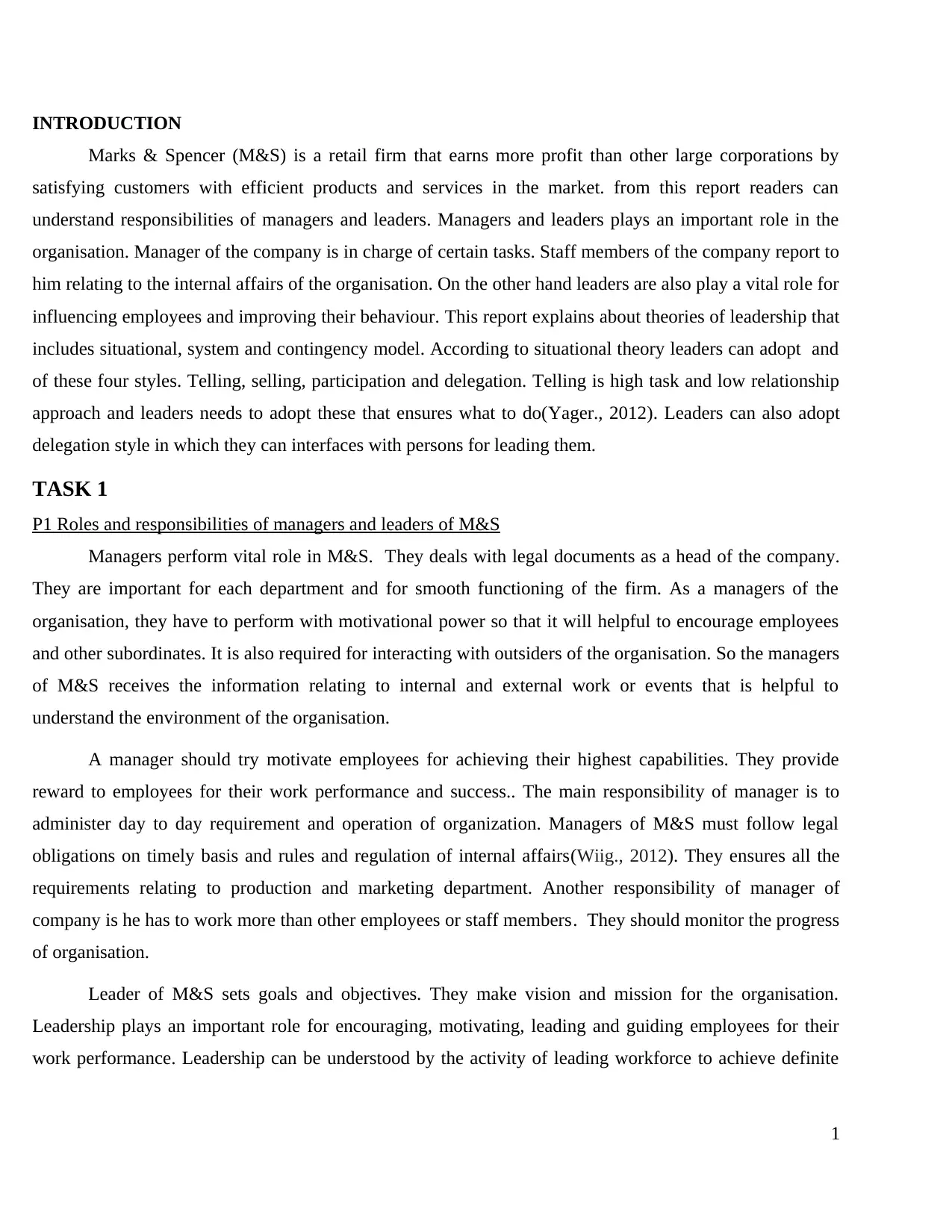
INTRODUCTION
Marks & Spencer (M&S) is a retail firm that earns more profit than other large corporations by
satisfying customers with efficient products and services in the market. from this report readers can
understand responsibilities of managers and leaders. Managers and leaders plays an important role in the
organisation. Manager of the company is in charge of certain tasks. Staff members of the company report to
him relating to the internal affairs of the organisation. On the other hand leaders are also play a vital role for
influencing employees and improving their behaviour. This report explains about theories of leadership that
includes situational, system and contingency model. According to situational theory leaders can adopt and
of these four styles. Telling, selling, participation and delegation. Telling is high task and low relationship
approach and leaders needs to adopt these that ensures what to do(Yager., 2012). Leaders can also adopt
delegation style in which they can interfaces with persons for leading them.
TASK 1
P1 Roles and responsibilities of managers and leaders of M&S
Managers perform vital role in M&S. They deals with legal documents as a head of the company.
They are important for each department and for smooth functioning of the firm. As a managers of the
organisation, they have to perform with motivational power so that it will helpful to encourage employees
and other subordinates. It is also required for interacting with outsiders of the organisation. So the managers
of M&S receives the information relating to internal and external work or events that is helpful to
understand the environment of the organisation.
A manager should try motivate employees for achieving their highest capabilities. They provide
reward to employees for their work performance and success.. The main responsibility of manager is to
administer day to day requirement and operation of organization. Managers of M&S must follow legal
obligations on timely basis and rules and regulation of internal affairs(Wiig., 2012). They ensures all the
requirements relating to production and marketing department. Another responsibility of manager of
company is he has to work more than other employees or staff members. They should monitor the progress
of organisation.
Leader of M&S sets goals and objectives. They make vision and mission for the organisation.
Leadership plays an important role for encouraging, motivating, leading and guiding employees for their
work performance. Leadership can be understood by the activity of leading workforce to achieve definite
1
Marks & Spencer (M&S) is a retail firm that earns more profit than other large corporations by
satisfying customers with efficient products and services in the market. from this report readers can
understand responsibilities of managers and leaders. Managers and leaders plays an important role in the
organisation. Manager of the company is in charge of certain tasks. Staff members of the company report to
him relating to the internal affairs of the organisation. On the other hand leaders are also play a vital role for
influencing employees and improving their behaviour. This report explains about theories of leadership that
includes situational, system and contingency model. According to situational theory leaders can adopt and
of these four styles. Telling, selling, participation and delegation. Telling is high task and low relationship
approach and leaders needs to adopt these that ensures what to do(Yager., 2012). Leaders can also adopt
delegation style in which they can interfaces with persons for leading them.
TASK 1
P1 Roles and responsibilities of managers and leaders of M&S
Managers perform vital role in M&S. They deals with legal documents as a head of the company.
They are important for each department and for smooth functioning of the firm. As a managers of the
organisation, they have to perform with motivational power so that it will helpful to encourage employees
and other subordinates. It is also required for interacting with outsiders of the organisation. So the managers
of M&S receives the information relating to internal and external work or events that is helpful to
understand the environment of the organisation.
A manager should try motivate employees for achieving their highest capabilities. They provide
reward to employees for their work performance and success.. The main responsibility of manager is to
administer day to day requirement and operation of organization. Managers of M&S must follow legal
obligations on timely basis and rules and regulation of internal affairs(Wiig., 2012). They ensures all the
requirements relating to production and marketing department. Another responsibility of manager of
company is he has to work more than other employees or staff members. They should monitor the progress
of organisation.
Leader of M&S sets goals and objectives. They make vision and mission for the organisation.
Leadership plays an important role for encouraging, motivating, leading and guiding employees for their
work performance. Leadership can be understood by the activity of leading workforce to achieve definite
1
⊘ This is a preview!⊘
Do you want full access?
Subscribe today to unlock all pages.

Trusted by 1+ million students worldwide
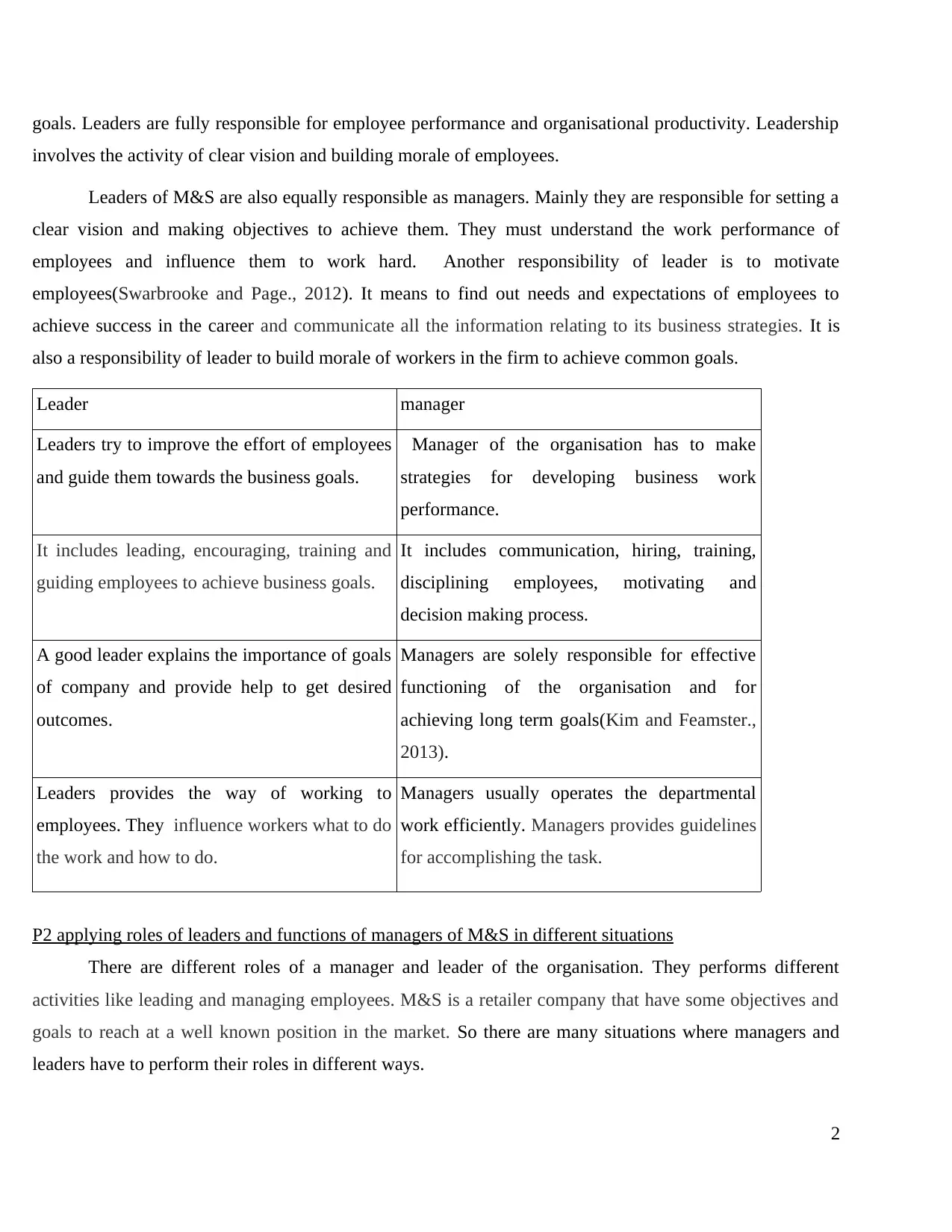
goals. Leaders are fully responsible for employee performance and organisational productivity. Leadership
involves the activity of clear vision and building morale of employees.
Leaders of M&S are also equally responsible as managers. Mainly they are responsible for setting a
clear vision and making objectives to achieve them. They must understand the work performance of
employees and influence them to work hard. Another responsibility of leader is to motivate
employees(Swarbrooke and Page., 2012). It means to find out needs and expectations of employees to
achieve success in the career and communicate all the information relating to its business strategies. It is
also a responsibility of leader to build morale of workers in the firm to achieve common goals.
Leader manager
Leaders try to improve the effort of employees
and guide them towards the business goals.
Manager of the organisation has to make
strategies for developing business work
performance.
It includes leading, encouraging, training and
guiding employees to achieve business goals.
It includes communication, hiring, training,
disciplining employees, motivating and
decision making process.
A good leader explains the importance of goals
of company and provide help to get desired
outcomes.
Managers are solely responsible for effective
functioning of the organisation and for
achieving long term goals(Kim and Feamster.,
2013).
Leaders provides the way of working to
employees. They influence workers what to do
the work and how to do.
Managers usually operates the departmental
work efficiently. Managers provides guidelines
for accomplishing the task.
P2 applying roles of leaders and functions of managers of M&S in different situations
There are different roles of a manager and leader of the organisation. They performs different
activities like leading and managing employees. M&S is a retailer company that have some objectives and
goals to reach at a well known position in the market. So there are many situations where managers and
leaders have to perform their roles in different ways.
2
involves the activity of clear vision and building morale of employees.
Leaders of M&S are also equally responsible as managers. Mainly they are responsible for setting a
clear vision and making objectives to achieve them. They must understand the work performance of
employees and influence them to work hard. Another responsibility of leader is to motivate
employees(Swarbrooke and Page., 2012). It means to find out needs and expectations of employees to
achieve success in the career and communicate all the information relating to its business strategies. It is
also a responsibility of leader to build morale of workers in the firm to achieve common goals.
Leader manager
Leaders try to improve the effort of employees
and guide them towards the business goals.
Manager of the organisation has to make
strategies for developing business work
performance.
It includes leading, encouraging, training and
guiding employees to achieve business goals.
It includes communication, hiring, training,
disciplining employees, motivating and
decision making process.
A good leader explains the importance of goals
of company and provide help to get desired
outcomes.
Managers are solely responsible for effective
functioning of the organisation and for
achieving long term goals(Kim and Feamster.,
2013).
Leaders provides the way of working to
employees. They influence workers what to do
the work and how to do.
Managers usually operates the departmental
work efficiently. Managers provides guidelines
for accomplishing the task.
P2 applying roles of leaders and functions of managers of M&S in different situations
There are different roles of a manager and leader of the organisation. They performs different
activities like leading and managing employees. M&S is a retailer company that have some objectives and
goals to reach at a well known position in the market. So there are many situations where managers and
leaders have to perform their roles in different ways.
2
Paraphrase This Document
Need a fresh take? Get an instant paraphrase of this document with our AI Paraphraser
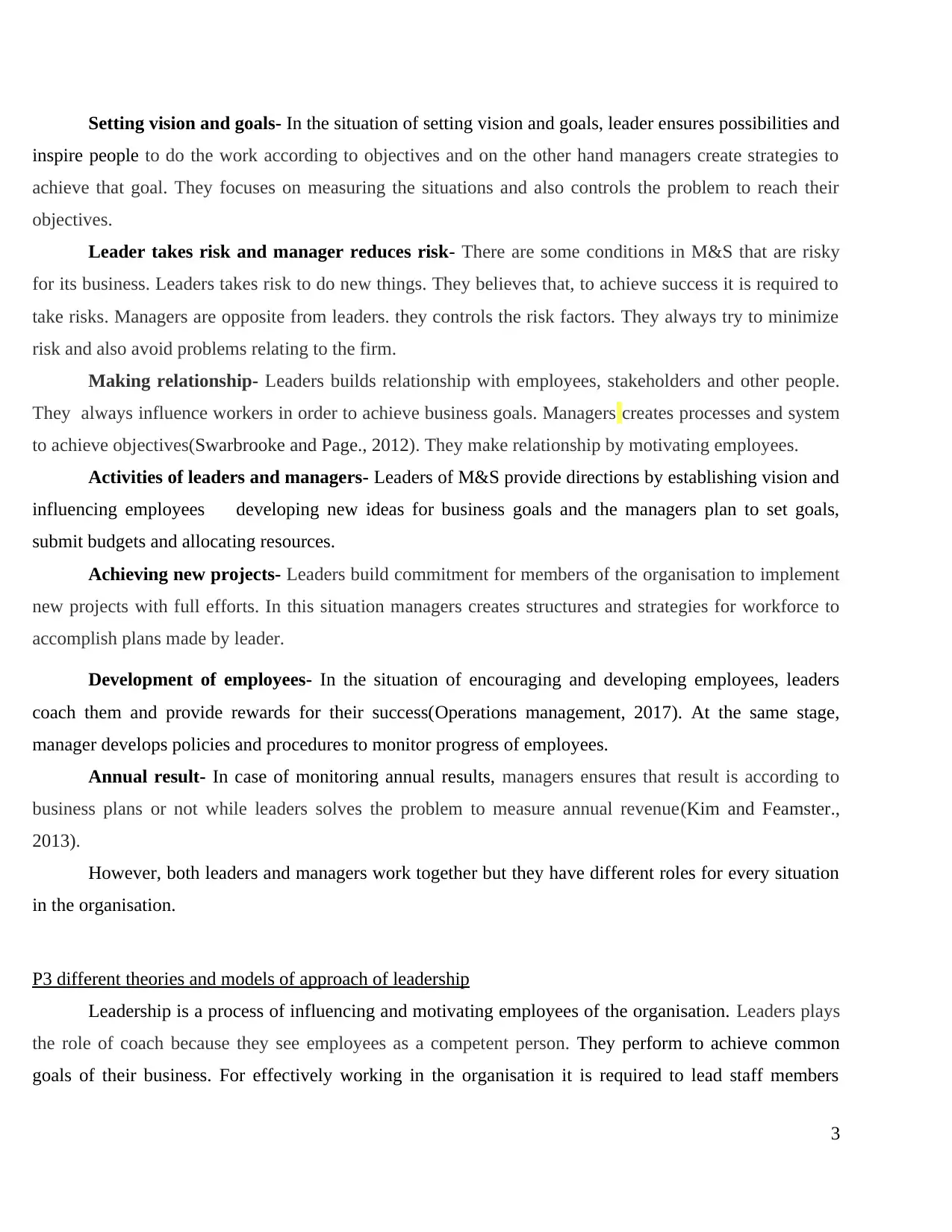
Setting vision and goals- In the situation of setting vision and goals, leader ensures possibilities and
inspire people to do the work according to objectives and on the other hand managers create strategies to
achieve that goal. They focuses on measuring the situations and also controls the problem to reach their
objectives.
Leader takes risk and manager reduces risk- There are some conditions in M&S that are risky
for its business. Leaders takes risk to do new things. They believes that, to achieve success it is required to
take risks. Managers are opposite from leaders. they controls the risk factors. They always try to minimize
risk and also avoid problems relating to the firm.
Making relationship- Leaders builds relationship with employees, stakeholders and other people.
They always influence workers in order to achieve business goals. Managers creates processes and system
to achieve objectives(Swarbrooke and Page., 2012). They make relationship by motivating employees.
Activities of leaders and managers- Leaders of M&S provide directions by establishing vision and
influencing employees developing new ideas for business goals and the managers plan to set goals,
submit budgets and allocating resources.
Achieving new projects- Leaders build commitment for members of the organisation to implement
new projects with full efforts. In this situation managers creates structures and strategies for workforce to
accomplish plans made by leader.
Development of employees- In the situation of encouraging and developing employees, leaders
coach them and provide rewards for their success(Operations management, 2017). At the same stage,
manager develops policies and procedures to monitor progress of employees.
Annual result- In case of monitoring annual results, managers ensures that result is according to
business plans or not while leaders solves the problem to measure annual revenue(Kim and Feamster.,
2013).
However, both leaders and managers work together but they have different roles for every situation
in the organisation.
P3 different theories and models of approach of leadership
Leadership is a process of influencing and motivating employees of the organisation. Leaders plays
the role of coach because they see employees as a competent person. They perform to achieve common
goals of their business. For effectively working in the organisation it is required to lead staff members
3
inspire people to do the work according to objectives and on the other hand managers create strategies to
achieve that goal. They focuses on measuring the situations and also controls the problem to reach their
objectives.
Leader takes risk and manager reduces risk- There are some conditions in M&S that are risky
for its business. Leaders takes risk to do new things. They believes that, to achieve success it is required to
take risks. Managers are opposite from leaders. they controls the risk factors. They always try to minimize
risk and also avoid problems relating to the firm.
Making relationship- Leaders builds relationship with employees, stakeholders and other people.
They always influence workers in order to achieve business goals. Managers creates processes and system
to achieve objectives(Swarbrooke and Page., 2012). They make relationship by motivating employees.
Activities of leaders and managers- Leaders of M&S provide directions by establishing vision and
influencing employees developing new ideas for business goals and the managers plan to set goals,
submit budgets and allocating resources.
Achieving new projects- Leaders build commitment for members of the organisation to implement
new projects with full efforts. In this situation managers creates structures and strategies for workforce to
accomplish plans made by leader.
Development of employees- In the situation of encouraging and developing employees, leaders
coach them and provide rewards for their success(Operations management, 2017). At the same stage,
manager develops policies and procedures to monitor progress of employees.
Annual result- In case of monitoring annual results, managers ensures that result is according to
business plans or not while leaders solves the problem to measure annual revenue(Kim and Feamster.,
2013).
However, both leaders and managers work together but they have different roles for every situation
in the organisation.
P3 different theories and models of approach of leadership
Leadership is a process of influencing and motivating employees of the organisation. Leaders plays
the role of coach because they see employees as a competent person. They perform to achieve common
goals of their business. For effectively working in the organisation it is required to lead staff members
3
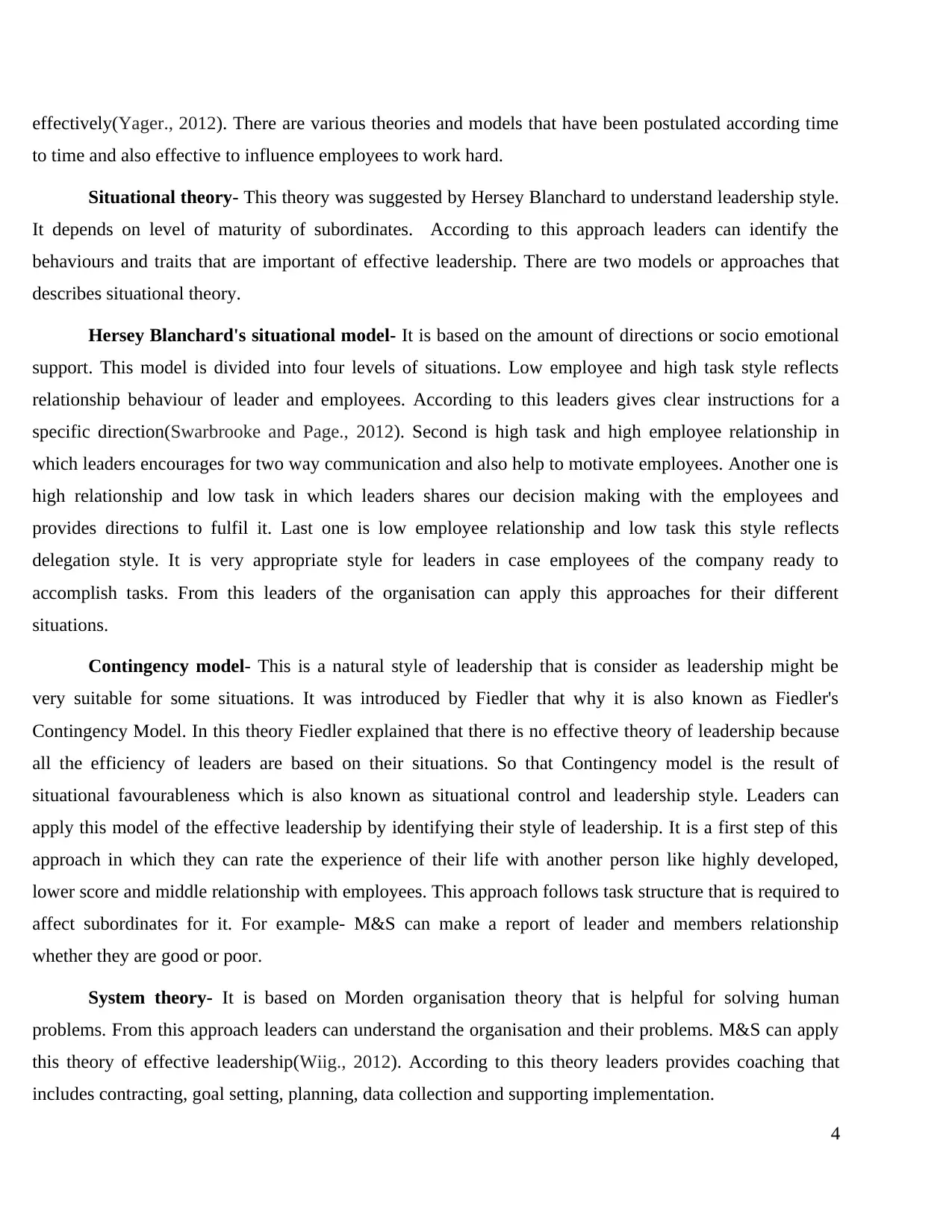
effectively(Yager., 2012). There are various theories and models that have been postulated according time
to time and also effective to influence employees to work hard.
Situational theory- This theory was suggested by Hersey Blanchard to understand leadership style.
It depends on level of maturity of subordinates. According to this approach leaders can identify the
behaviours and traits that are important of effective leadership. There are two models or approaches that
describes situational theory.
Hersey Blanchard's situational model- It is based on the amount of directions or socio emotional
support. This model is divided into four levels of situations. Low employee and high task style reflects
relationship behaviour of leader and employees. According to this leaders gives clear instructions for a
specific direction(Swarbrooke and Page., 2012). Second is high task and high employee relationship in
which leaders encourages for two way communication and also help to motivate employees. Another one is
high relationship and low task in which leaders shares our decision making with the employees and
provides directions to fulfil it. Last one is low employee relationship and low task this style reflects
delegation style. It is very appropriate style for leaders in case employees of the company ready to
accomplish tasks. From this leaders of the organisation can apply this approaches for their different
situations.
Contingency model- This is a natural style of leadership that is consider as leadership might be
very suitable for some situations. It was introduced by Fiedler that why it is also known as Fiedler's
Contingency Model. In this theory Fiedler explained that there is no effective theory of leadership because
all the efficiency of leaders are based on their situations. So that Contingency model is the result of
situational favourableness which is also known as situational control and leadership style. Leaders can
apply this model of the effective leadership by identifying their style of leadership. It is a first step of this
approach in which they can rate the experience of their life with another person like highly developed,
lower score and middle relationship with employees. This approach follows task structure that is required to
affect subordinates for it. For example- M&S can make a report of leader and members relationship
whether they are good or poor.
System theory- It is based on Morden organisation theory that is helpful for solving human
problems. From this approach leaders can understand the organisation and their problems. M&S can apply
this theory of effective leadership(Wiig., 2012). According to this theory leaders provides coaching that
includes contracting, goal setting, planning, data collection and supporting implementation.
4
to time and also effective to influence employees to work hard.
Situational theory- This theory was suggested by Hersey Blanchard to understand leadership style.
It depends on level of maturity of subordinates. According to this approach leaders can identify the
behaviours and traits that are important of effective leadership. There are two models or approaches that
describes situational theory.
Hersey Blanchard's situational model- It is based on the amount of directions or socio emotional
support. This model is divided into four levels of situations. Low employee and high task style reflects
relationship behaviour of leader and employees. According to this leaders gives clear instructions for a
specific direction(Swarbrooke and Page., 2012). Second is high task and high employee relationship in
which leaders encourages for two way communication and also help to motivate employees. Another one is
high relationship and low task in which leaders shares our decision making with the employees and
provides directions to fulfil it. Last one is low employee relationship and low task this style reflects
delegation style. It is very appropriate style for leaders in case employees of the company ready to
accomplish tasks. From this leaders of the organisation can apply this approaches for their different
situations.
Contingency model- This is a natural style of leadership that is consider as leadership might be
very suitable for some situations. It was introduced by Fiedler that why it is also known as Fiedler's
Contingency Model. In this theory Fiedler explained that there is no effective theory of leadership because
all the efficiency of leaders are based on their situations. So that Contingency model is the result of
situational favourableness which is also known as situational control and leadership style. Leaders can
apply this model of the effective leadership by identifying their style of leadership. It is a first step of this
approach in which they can rate the experience of their life with another person like highly developed,
lower score and middle relationship with employees. This approach follows task structure that is required to
affect subordinates for it. For example- M&S can make a report of leader and members relationship
whether they are good or poor.
System theory- It is based on Morden organisation theory that is helpful for solving human
problems. From this approach leaders can understand the organisation and their problems. M&S can apply
this theory of effective leadership(Wiig., 2012). According to this theory leaders provides coaching that
includes contracting, goal setting, planning, data collection and supporting implementation.
4
⊘ This is a preview!⊘
Do you want full access?
Subscribe today to unlock all pages.

Trusted by 1+ million students worldwide
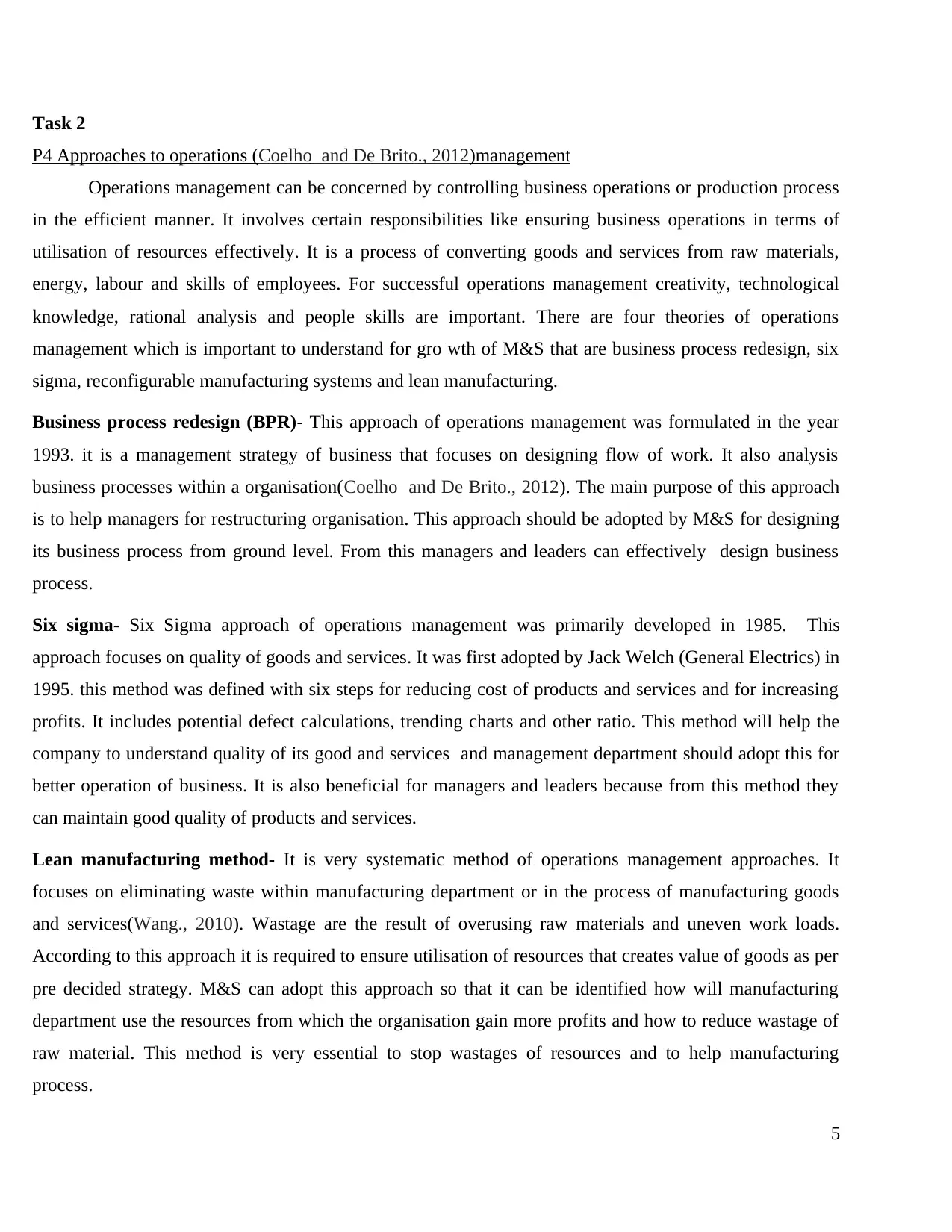
Task 2
P4 Approaches to operations (Coelho and De Brito., 2012)management
Operations management can be concerned by controlling business operations or production process
in the efficient manner. It involves certain responsibilities like ensuring business operations in terms of
utilisation of resources effectively. It is a process of converting goods and services from raw materials,
energy, labour and skills of employees. For successful operations management creativity, technological
knowledge, rational analysis and people skills are important. There are four theories of operations
management which is important to understand for gro wth of M&S that are business process redesign, six
sigma, reconfigurable manufacturing systems and lean manufacturing.
Business process redesign (BPR)- This approach of operations management was formulated in the year
1993. it is a management strategy of business that focuses on designing flow of work. It also analysis
business processes within a organisation(Coelho and De Brito., 2012). The main purpose of this approach
is to help managers for restructuring organisation. This approach should be adopted by M&S for designing
its business process from ground level. From this managers and leaders can effectively design business
process.
Six sigma- Six Sigma approach of operations management was primarily developed in 1985. This
approach focuses on quality of goods and services. It was first adopted by Jack Welch (General Electrics) in
1995. this method was defined with six steps for reducing cost of products and services and for increasing
profits. It includes potential defect calculations, trending charts and other ratio. This method will help the
company to understand quality of its good and services and management department should adopt this for
better operation of business. It is also beneficial for managers and leaders because from this method they
can maintain good quality of products and services.
Lean manufacturing method- It is very systematic method of operations management approaches. It
focuses on eliminating waste within manufacturing department or in the process of manufacturing goods
and services(Wang., 2010). Wastage are the result of overusing raw materials and uneven work loads.
According to this approach it is required to ensure utilisation of resources that creates value of goods as per
pre decided strategy. M&S can adopt this approach so that it can be identified how will manufacturing
department use the resources from which the organisation gain more profits and how to reduce wastage of
raw material. This method is very essential to stop wastages of resources and to help manufacturing
process.
5
P4 Approaches to operations (Coelho and De Brito., 2012)management
Operations management can be concerned by controlling business operations or production process
in the efficient manner. It involves certain responsibilities like ensuring business operations in terms of
utilisation of resources effectively. It is a process of converting goods and services from raw materials,
energy, labour and skills of employees. For successful operations management creativity, technological
knowledge, rational analysis and people skills are important. There are four theories of operations
management which is important to understand for gro wth of M&S that are business process redesign, six
sigma, reconfigurable manufacturing systems and lean manufacturing.
Business process redesign (BPR)- This approach of operations management was formulated in the year
1993. it is a management strategy of business that focuses on designing flow of work. It also analysis
business processes within a organisation(Coelho and De Brito., 2012). The main purpose of this approach
is to help managers for restructuring organisation. This approach should be adopted by M&S for designing
its business process from ground level. From this managers and leaders can effectively design business
process.
Six sigma- Six Sigma approach of operations management was primarily developed in 1985. This
approach focuses on quality of goods and services. It was first adopted by Jack Welch (General Electrics) in
1995. this method was defined with six steps for reducing cost of products and services and for increasing
profits. It includes potential defect calculations, trending charts and other ratio. This method will help the
company to understand quality of its good and services and management department should adopt this for
better operation of business. It is also beneficial for managers and leaders because from this method they
can maintain good quality of products and services.
Lean manufacturing method- It is very systematic method of operations management approaches. It
focuses on eliminating waste within manufacturing department or in the process of manufacturing goods
and services(Wang., 2010). Wastage are the result of overusing raw materials and uneven work loads.
According to this approach it is required to ensure utilisation of resources that creates value of goods as per
pre decided strategy. M&S can adopt this approach so that it can be identified how will manufacturing
department use the resources from which the organisation gain more profits and how to reduce wastage of
raw material. This method is very essential to stop wastages of resources and to help manufacturing
process.
5
Paraphrase This Document
Need a fresh take? Get an instant paraphrase of this document with our AI Paraphraser
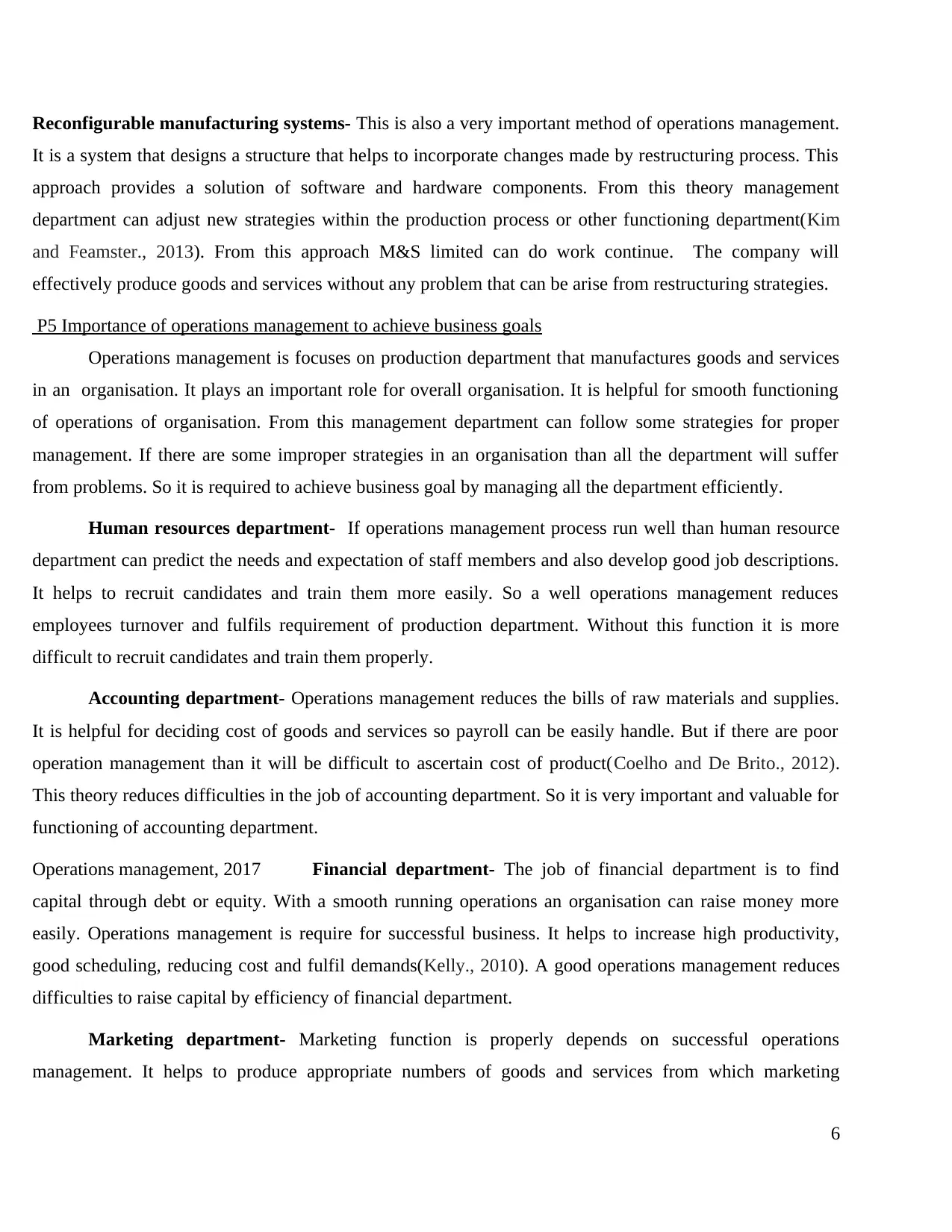
Reconfigurable manufacturing systems- This is also a very important method of operations management.
It is a system that designs a structure that helps to incorporate changes made by restructuring process. This
approach provides a solution of software and hardware components. From this theory management
department can adjust new strategies within the production process or other functioning department(Kim
and Feamster., 2013). From this approach M&S limited can do work continue. The company will
effectively produce goods and services without any problem that can be arise from restructuring strategies.
P5 Importance of operations management to achieve business goals
Operations management is focuses on production department that manufactures goods and services
in an organisation. It plays an important role for overall organisation. It is helpful for smooth functioning
of operations of organisation. From this management department can follow some strategies for proper
management. If there are some improper strategies in an organisation than all the department will suffer
from problems. So it is required to achieve business goal by managing all the department efficiently.
Human resources department- If operations management process run well than human resource
department can predict the needs and expectation of staff members and also develop good job descriptions.
It helps to recruit candidates and train them more easily. So a well operations management reduces
employees turnover and fulfils requirement of production department. Without this function it is more
difficult to recruit candidates and train them properly.
Accounting department- Operations management reduces the bills of raw materials and supplies.
It is helpful for deciding cost of goods and services so payroll can be easily handle. But if there are poor
operation management than it will be difficult to ascertain cost of product(Coelho and De Brito., 2012).
This theory reduces difficulties in the job of accounting department. So it is very important and valuable for
functioning of accounting department.
Operations management, 2017 Financial department- The job of financial department is to find
capital through debt or equity. With a smooth running operations an organisation can raise money more
easily. Operations management is require for successful business. It helps to increase high productivity,
good scheduling, reducing cost and fulfil demands(Kelly., 2010). A good operations management reduces
difficulties to raise capital by efficiency of financial department.
Marketing department- Marketing function is properly depends on successful operations
management. It helps to produce appropriate numbers of goods and services from which marketing
6
It is a system that designs a structure that helps to incorporate changes made by restructuring process. This
approach provides a solution of software and hardware components. From this theory management
department can adjust new strategies within the production process or other functioning department(Kim
and Feamster., 2013). From this approach M&S limited can do work continue. The company will
effectively produce goods and services without any problem that can be arise from restructuring strategies.
P5 Importance of operations management to achieve business goals
Operations management is focuses on production department that manufactures goods and services
in an organisation. It plays an important role for overall organisation. It is helpful for smooth functioning
of operations of organisation. From this management department can follow some strategies for proper
management. If there are some improper strategies in an organisation than all the department will suffer
from problems. So it is required to achieve business goal by managing all the department efficiently.
Human resources department- If operations management process run well than human resource
department can predict the needs and expectation of staff members and also develop good job descriptions.
It helps to recruit candidates and train them more easily. So a well operations management reduces
employees turnover and fulfils requirement of production department. Without this function it is more
difficult to recruit candidates and train them properly.
Accounting department- Operations management reduces the bills of raw materials and supplies.
It is helpful for deciding cost of goods and services so payroll can be easily handle. But if there are poor
operation management than it will be difficult to ascertain cost of product(Coelho and De Brito., 2012).
This theory reduces difficulties in the job of accounting department. So it is very important and valuable for
functioning of accounting department.
Operations management, 2017 Financial department- The job of financial department is to find
capital through debt or equity. With a smooth running operations an organisation can raise money more
easily. Operations management is require for successful business. It helps to increase high productivity,
good scheduling, reducing cost and fulfil demands(Kelly., 2010). A good operations management reduces
difficulties to raise capital by efficiency of financial department.
Marketing department- Marketing function is properly depends on successful operations
management. It helps to produce appropriate numbers of goods and services from which marketing
6
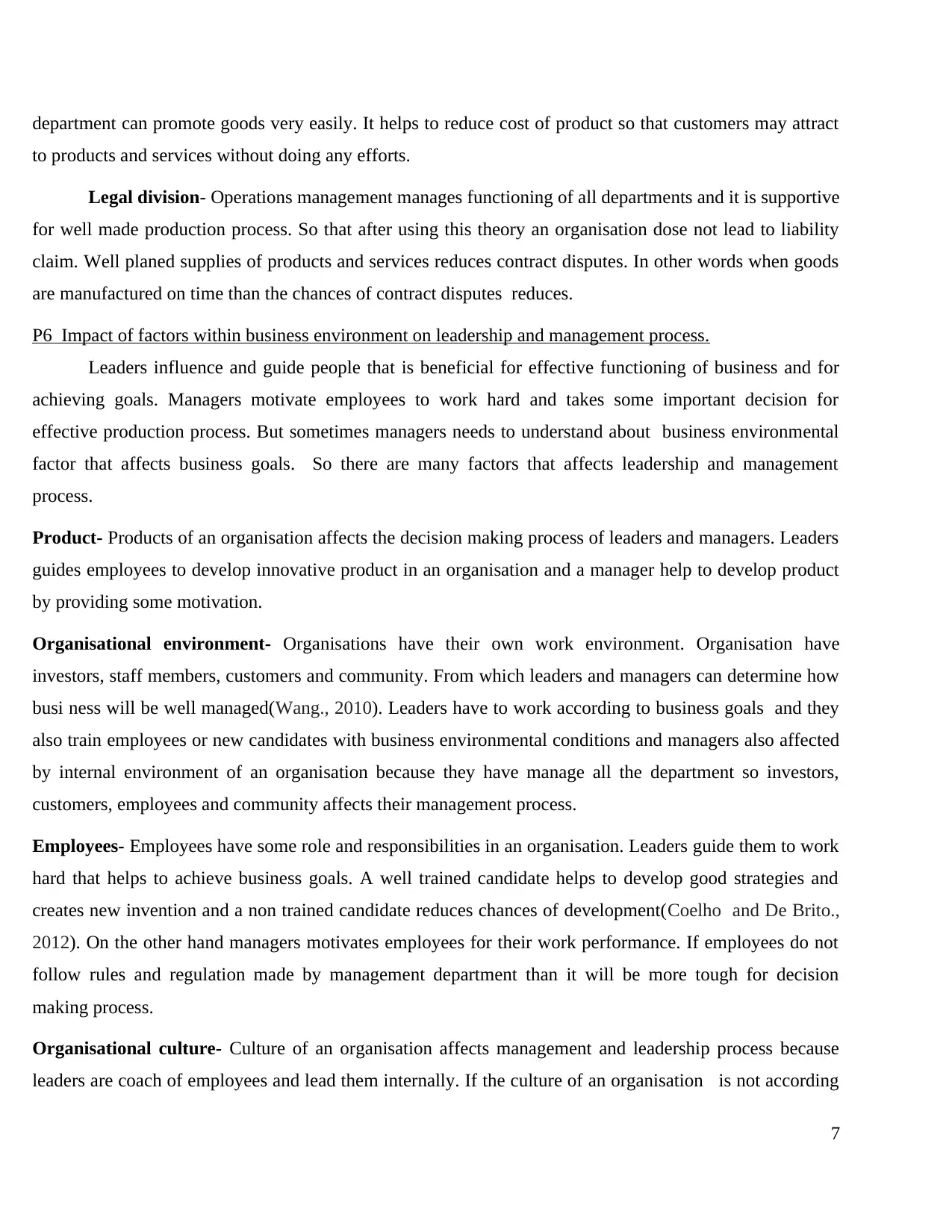
department can promote goods very easily. It helps to reduce cost of product so that customers may attract
to products and services without doing any efforts.
Legal division- Operations management manages functioning of all departments and it is supportive
for well made production process. So that after using this theory an organisation dose not lead to liability
claim. Well planed supplies of products and services reduces contract disputes. In other words when goods
are manufactured on time than the chances of contract disputes reduces.
P6 Impact of factors within business environment on leadership and management process.
Leaders influence and guide people that is beneficial for effective functioning of business and for
achieving goals. Managers motivate employees to work hard and takes some important decision for
effective production process. But sometimes managers needs to understand about business environmental
factor that affects business goals. So there are many factors that affects leadership and management
process.
Product- Products of an organisation affects the decision making process of leaders and managers. Leaders
guides employees to develop innovative product in an organisation and a manager help to develop product
by providing some motivation.
Organisational environment- Organisations have their own work environment. Organisation have
investors, staff members, customers and community. From which leaders and managers can determine how
busi ness will be well managed(Wang., 2010). Leaders have to work according to business goals and they
also train employees or new candidates with business environmental conditions and managers also affected
by internal environment of an organisation because they have manage all the department so investors,
customers, employees and community affects their management process.
Employees- Employees have some role and responsibilities in an organisation. Leaders guide them to work
hard that helps to achieve business goals. A well trained candidate helps to develop good strategies and
creates new invention and a non trained candidate reduces chances of development(Coelho and De Brito.,
2012). On the other hand managers motivates employees for their work performance. If employees do not
follow rules and regulation made by management department than it will be more tough for decision
making process.
Organisational culture- Culture of an organisation affects management and leadership process because
leaders are coach of employees and lead them internally. If the culture of an organisation is not according
7
to products and services without doing any efforts.
Legal division- Operations management manages functioning of all departments and it is supportive
for well made production process. So that after using this theory an organisation dose not lead to liability
claim. Well planed supplies of products and services reduces contract disputes. In other words when goods
are manufactured on time than the chances of contract disputes reduces.
P6 Impact of factors within business environment on leadership and management process.
Leaders influence and guide people that is beneficial for effective functioning of business and for
achieving goals. Managers motivate employees to work hard and takes some important decision for
effective production process. But sometimes managers needs to understand about business environmental
factor that affects business goals. So there are many factors that affects leadership and management
process.
Product- Products of an organisation affects the decision making process of leaders and managers. Leaders
guides employees to develop innovative product in an organisation and a manager help to develop product
by providing some motivation.
Organisational environment- Organisations have their own work environment. Organisation have
investors, staff members, customers and community. From which leaders and managers can determine how
busi ness will be well managed(Wang., 2010). Leaders have to work according to business goals and they
also train employees or new candidates with business environmental conditions and managers also affected
by internal environment of an organisation because they have manage all the department so investors,
customers, employees and community affects their management process.
Employees- Employees have some role and responsibilities in an organisation. Leaders guide them to work
hard that helps to achieve business goals. A well trained candidate helps to develop good strategies and
creates new invention and a non trained candidate reduces chances of development(Coelho and De Brito.,
2012). On the other hand managers motivates employees for their work performance. If employees do not
follow rules and regulation made by management department than it will be more tough for decision
making process.
Organisational culture- Culture of an organisation affects management and leadership process because
leaders are coach of employees and lead them internally. If the culture of an organisation is not according
7
⊘ This is a preview!⊘
Do you want full access?
Subscribe today to unlock all pages.

Trusted by 1+ million students worldwide
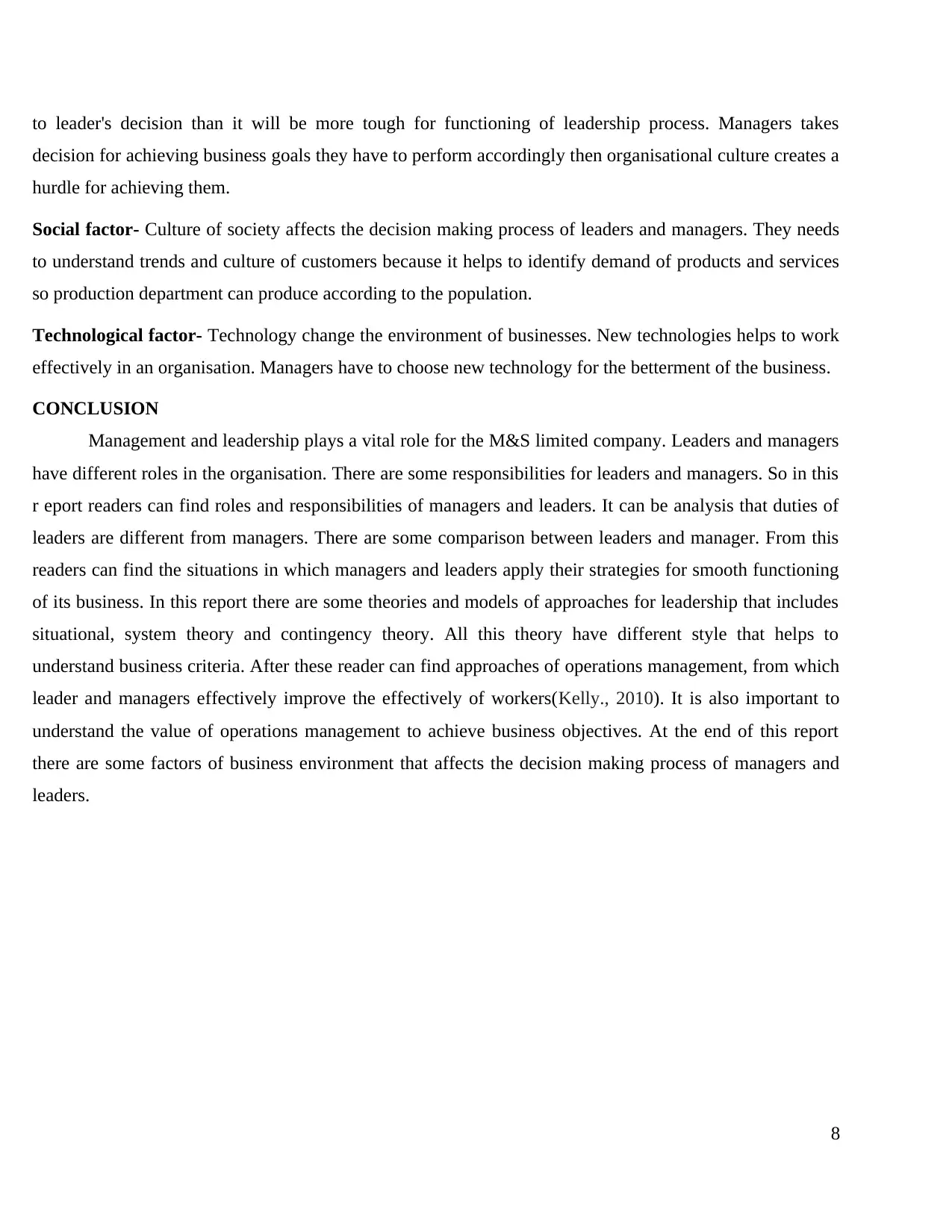
to leader's decision than it will be more tough for functioning of leadership process. Managers takes
decision for achieving business goals they have to perform accordingly then organisational culture creates a
hurdle for achieving them.
Social factor- Culture of society affects the decision making process of leaders and managers. They needs
to understand trends and culture of customers because it helps to identify demand of products and services
so production department can produce according to the population.
Technological factor- Technology change the environment of businesses. New technologies helps to work
effectively in an organisation. Managers have to choose new technology for the betterment of the business.
CONCLUSION
Management and leadership plays a vital role for the M&S limited company. Leaders and managers
have different roles in the organisation. There are some responsibilities for leaders and managers. So in this
r eport readers can find roles and responsibilities of managers and leaders. It can be analysis that duties of
leaders are different from managers. There are some comparison between leaders and manager. From this
readers can find the situations in which managers and leaders apply their strategies for smooth functioning
of its business. In this report there are some theories and models of approaches for leadership that includes
situational, system theory and contingency theory. All this theory have different style that helps to
understand business criteria. After these reader can find approaches of operations management, from which
leader and managers effectively improve the effectively of workers(Kelly., 2010). It is also important to
understand the value of operations management to achieve business objectives. At the end of this report
there are some factors of business environment that affects the decision making process of managers and
leaders.
8
decision for achieving business goals they have to perform accordingly then organisational culture creates a
hurdle for achieving them.
Social factor- Culture of society affects the decision making process of leaders and managers. They needs
to understand trends and culture of customers because it helps to identify demand of products and services
so production department can produce according to the population.
Technological factor- Technology change the environment of businesses. New technologies helps to work
effectively in an organisation. Managers have to choose new technology for the betterment of the business.
CONCLUSION
Management and leadership plays a vital role for the M&S limited company. Leaders and managers
have different roles in the organisation. There are some responsibilities for leaders and managers. So in this
r eport readers can find roles and responsibilities of managers and leaders. It can be analysis that duties of
leaders are different from managers. There are some comparison between leaders and manager. From this
readers can find the situations in which managers and leaders apply their strategies for smooth functioning
of its business. In this report there are some theories and models of approaches for leadership that includes
situational, system theory and contingency theory. All this theory have different style that helps to
understand business criteria. After these reader can find approaches of operations management, from which
leader and managers effectively improve the effectively of workers(Kelly., 2010). It is also important to
understand the value of operations management to achieve business objectives. At the end of this report
there are some factors of business environment that affects the decision making process of managers and
leaders.
8
Paraphrase This Document
Need a fresh take? Get an instant paraphrase of this document with our AI Paraphraser
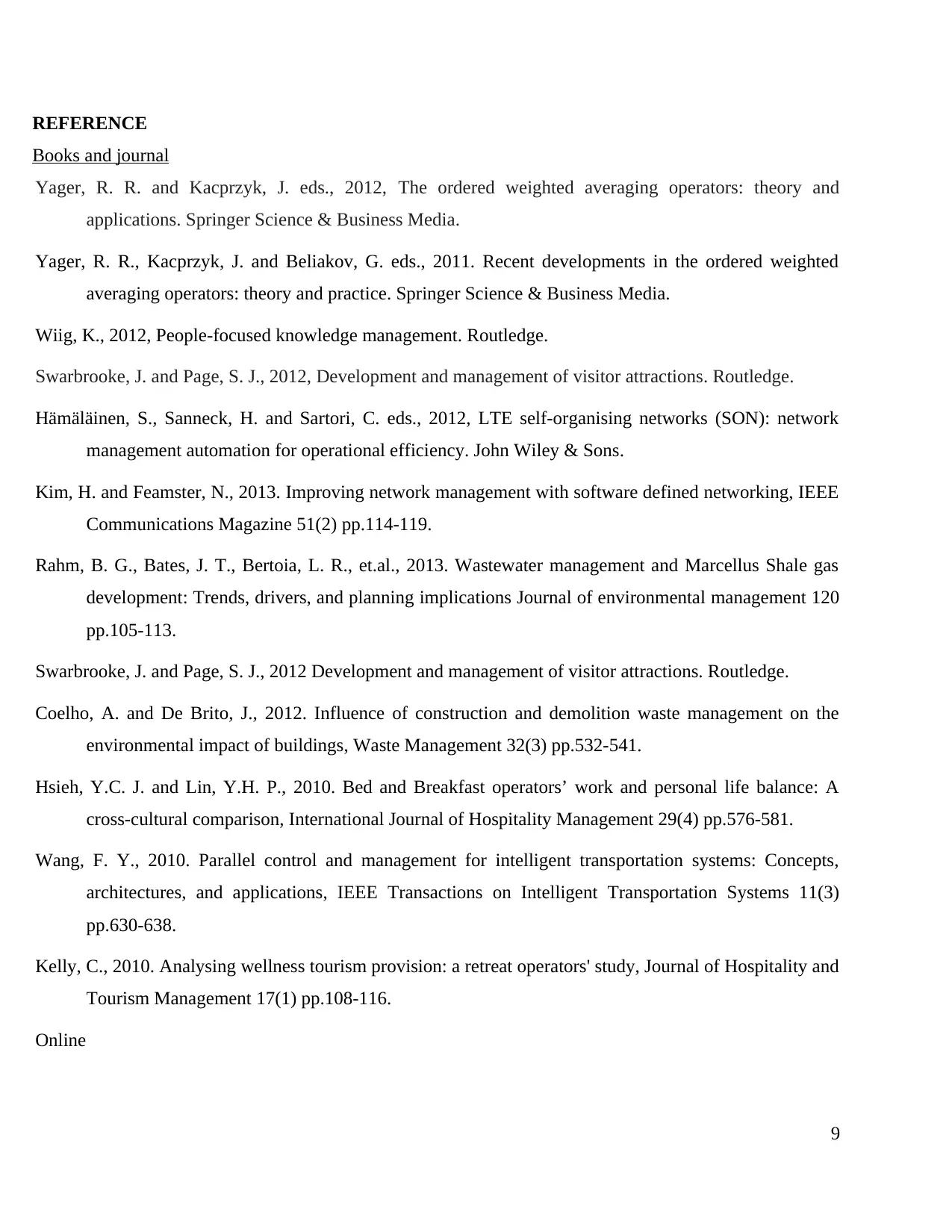
REFERENCE
Books and journal
Yager, R. R. and Kacprzyk, J. eds., 2012, The ordered weighted averaging operators: theory and
applications. Springer Science & Business Media.
Yager, R. R., Kacprzyk, J. and Beliakov, G. eds., 2011. Recent developments in the ordered weighted
averaging operators: theory and practice. Springer Science & Business Media.
Wiig, K., 2012, People-focused knowledge management. Routledge.
Swarbrooke, J. and Page, S. J., 2012, Development and management of visitor attractions. Routledge.
Hämäläinen, S., Sanneck, H. and Sartori, C. eds., 2012, LTE self-organising networks (SON): network
management automation for operational efficiency. John Wiley & Sons.
Kim, H. and Feamster, N., 2013. Improving network management with software defined networking, IEEE
Communications Magazine 51(2) pp.114-119.
Rahm, B. G., Bates, J. T., Bertoia, L. R., et.al., 2013. Wastewater management and Marcellus Shale gas
development: Trends, drivers, and planning implications Journal of environmental management 120
pp.105-113.
Swarbrooke, J. and Page, S. J., 2012 Development and management of visitor attractions. Routledge.
Coelho, A. and De Brito, J., 2012. Influence of construction and demolition waste management on the
environmental impact of buildings, Waste Management 32(3) pp.532-541.
Hsieh, Y.C. J. and Lin, Y.H. P., 2010. Bed and Breakfast operators’ work and personal life balance: A
cross-cultural comparison, International Journal of Hospitality Management 29(4) pp.576-581.
Wang, F. Y., 2010. Parallel control and management for intelligent transportation systems: Concepts,
architectures, and applications, IEEE Transactions on Intelligent Transportation Systems 11(3)
pp.630-638.
Kelly, C., 2010. Analysing wellness tourism provision: a retreat operators' study, Journal of Hospitality and
Tourism Management 17(1) pp.108-116.
Online
9
Books and journal
Yager, R. R. and Kacprzyk, J. eds., 2012, The ordered weighted averaging operators: theory and
applications. Springer Science & Business Media.
Yager, R. R., Kacprzyk, J. and Beliakov, G. eds., 2011. Recent developments in the ordered weighted
averaging operators: theory and practice. Springer Science & Business Media.
Wiig, K., 2012, People-focused knowledge management. Routledge.
Swarbrooke, J. and Page, S. J., 2012, Development and management of visitor attractions. Routledge.
Hämäläinen, S., Sanneck, H. and Sartori, C. eds., 2012, LTE self-organising networks (SON): network
management automation for operational efficiency. John Wiley & Sons.
Kim, H. and Feamster, N., 2013. Improving network management with software defined networking, IEEE
Communications Magazine 51(2) pp.114-119.
Rahm, B. G., Bates, J. T., Bertoia, L. R., et.al., 2013. Wastewater management and Marcellus Shale gas
development: Trends, drivers, and planning implications Journal of environmental management 120
pp.105-113.
Swarbrooke, J. and Page, S. J., 2012 Development and management of visitor attractions. Routledge.
Coelho, A. and De Brito, J., 2012. Influence of construction and demolition waste management on the
environmental impact of buildings, Waste Management 32(3) pp.532-541.
Hsieh, Y.C. J. and Lin, Y.H. P., 2010. Bed and Breakfast operators’ work and personal life balance: A
cross-cultural comparison, International Journal of Hospitality Management 29(4) pp.576-581.
Wang, F. Y., 2010. Parallel control and management for intelligent transportation systems: Concepts,
architectures, and applications, IEEE Transactions on Intelligent Transportation Systems 11(3)
pp.630-638.
Kelly, C., 2010. Analysing wellness tourism provision: a retreat operators' study, Journal of Hospitality and
Tourism Management 17(1) pp.108-116.
Online
9
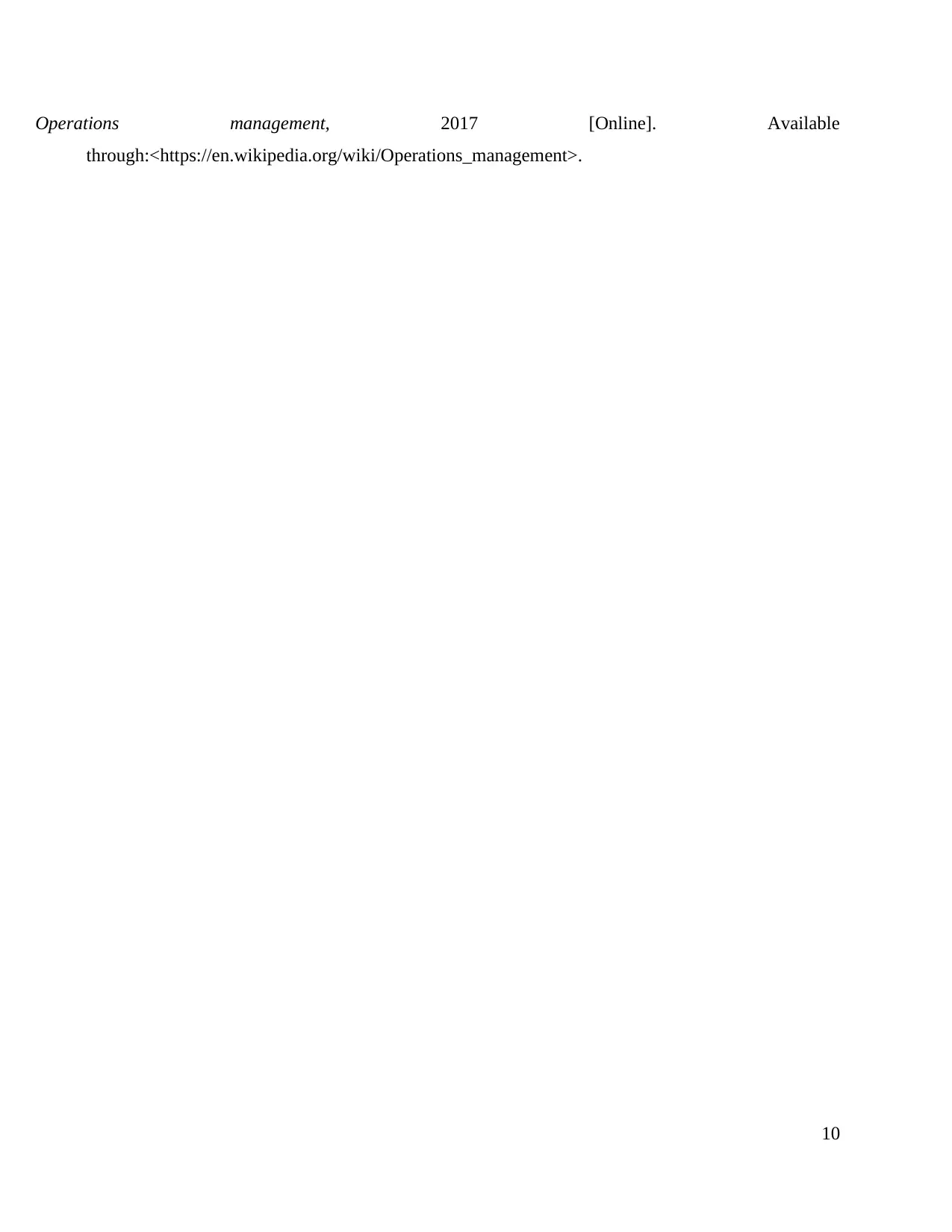
Operations management, 2017 [Online]. Available
through:<https://en.wikipedia.org/wiki/Operations_management>.
10
through:<https://en.wikipedia.org/wiki/Operations_management>.
10
⊘ This is a preview!⊘
Do you want full access?
Subscribe today to unlock all pages.

Trusted by 1+ million students worldwide
1 out of 12
Related Documents
Your All-in-One AI-Powered Toolkit for Academic Success.
+13062052269
info@desklib.com
Available 24*7 on WhatsApp / Email
![[object Object]](/_next/static/media/star-bottom.7253800d.svg)
Unlock your academic potential
Copyright © 2020–2025 A2Z Services. All Rights Reserved. Developed and managed by ZUCOL.





